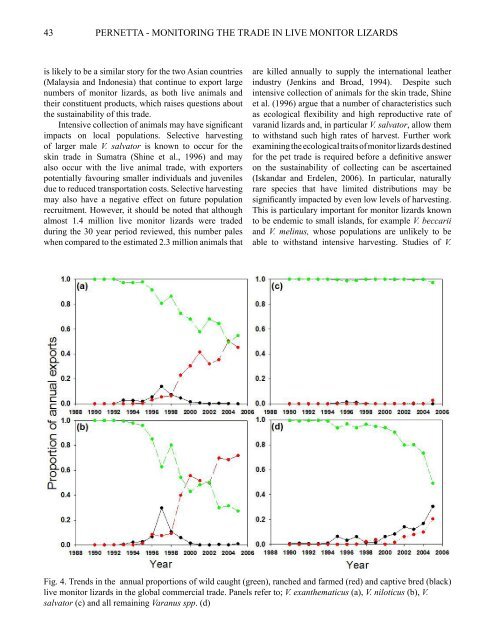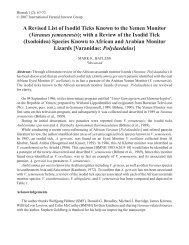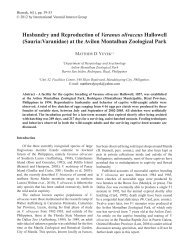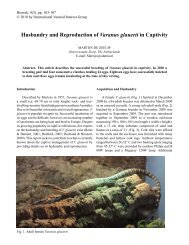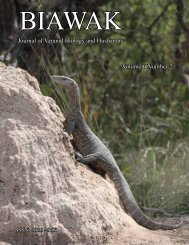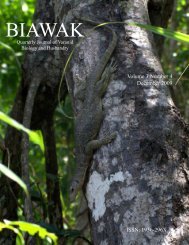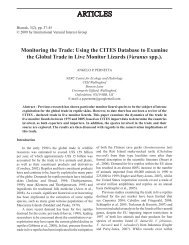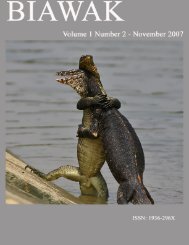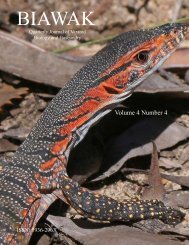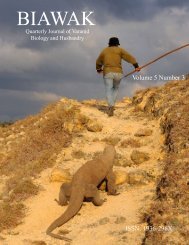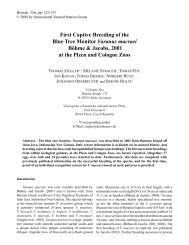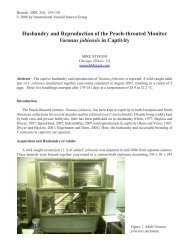BIAWAK - International Varanid Interest Group
BIAWAK - International Varanid Interest Group
BIAWAK - International Varanid Interest Group
Create successful ePaper yourself
Turn your PDF publications into a flip-book with our unique Google optimized e-Paper software.
43<br />
PERNETTA - MONITORINg THE TRADE IN LIVE MONITOR LIzARDs<br />
is likely to be a similar story for the two Asian countries<br />
(Malaysia and Indonesia) that continue to export large<br />
numbers of monitor lizards, as both live animals and<br />
their constituent products, which raises questions about<br />
the sustainability of this trade.<br />
Intensive collection of animals may have significant<br />
impacts on local populations. Selective harvesting<br />
of larger male V. salvator is known to occur for the<br />
skin trade in Sumatra (Shine et al., 1996) and may<br />
also occur with the live animal trade, with exporters<br />
potentially favouring smaller individuals and juveniles<br />
due to reduced transportation costs. Selective harvesting<br />
may also have a negative effect on future population<br />
recruitment. However, it should be noted that although<br />
almost 1.4 million live monitor lizards were traded<br />
during the 30 year period reviewed, this number pales<br />
when compared to the estimated 2.3 million animals that<br />
are killed annually to supply the international leather<br />
industry (Jenkins and Broad, 1994). Despite such<br />
intensive collection of animals for the skin trade, Shine<br />
et al. (1996) argue that a number of characteristics such<br />
as ecological flexibility and high reproductive rate of<br />
varanid lizards and, in particular V. salvator, allow them<br />
to withstand such high rates of harvest. Further work<br />
examining the ecological traits of monitor lizards destined<br />
for the pet trade is required before a definitive answer<br />
on the sustainability of collecting can be ascertained<br />
(Iskandar and Erdelen, 2006). In particular, naturally<br />
rare species that have limited distributions may be<br />
significantly impacted by even low levels of harvesting.<br />
This is particulary important for monitor lizards known<br />
to be endemic to small islands, for example V. beccarii<br />
and V. melinus, whose populations are unlikely to be<br />
able to withstand intensive harvesting. Studies of V.<br />
Fig. 4. Trends in the annual proportions of wild caught (green), ranched and farmed (red) and captive bred (black)<br />
live monitor lizards in the global commercial trade. Panels refer to; V. exanthematicus (a), V. niloticus (b), V.<br />
salvator (c) and all remaining Varanus spp. (d)


